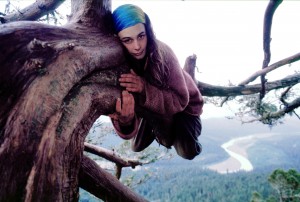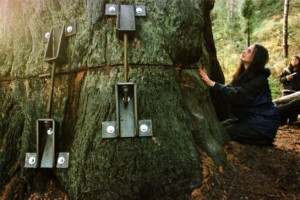Today is the 15 year anniversary of the end of Julia Butterfly Hill’s nonviolent campaign to protect the Redwood trees of Humboldt County California from extensive logging.
 The town of Stafford in Humboldt California was a primary lumber producing town in northern California from 1885 to 1985. In 1996, Pacific Lumber Company (PLC) initiated a policy of clear cutting the trees, a method of logging in which all trees are removed from a given tract of forest. Many community members were against the new policy, not only for the extreme ecological degradation caused by the method, but also because the trees in Stafford acted as a natural barrier against mudslides in the city’s wet winter months.
The town of Stafford in Humboldt California was a primary lumber producing town in northern California from 1885 to 1985. In 1996, Pacific Lumber Company (PLC) initiated a policy of clear cutting the trees, a method of logging in which all trees are removed from a given tract of forest. Many community members were against the new policy, not only for the extreme ecological degradation caused by the method, but also because the trees in Stafford acted as a natural barrier against mudslides in the city’s wet winter months.
Earth First!, founded in 1980, is an ecological resistance group, still very active today, dedicated to advocating for various environmental causes. In 1996, Earth First! conducted tree sit-ins to protest the logging of redwood trees.
Julia Hill, the most famous activist from the movement, met Earth First! organizers in 1997 upon relocating to California from Arkansas. A year earlier, Hill had been in an almost fatal car accident. Some observers have noted that the accident and its effect on Hill’s life bears an uncanny resemblance to an industrial accident that nearly blinded environmentalist John Muir, who changed his way of living after the incident and thereafter began to fight for wilderness preservation.
 As soon as she connected with a group of tree sitters, she found herself sitting in Luna, a name given to one of the chosen redwood trees, 180 feet up sitting on a small makeshift platform. She had to leave after six days due to illness. Once she recovered, Hill was back in Luna on December 10, 1997 and stayed for 738 days.
As soon as she connected with a group of tree sitters, she found herself sitting in Luna, a name given to one of the chosen redwood trees, 180 feet up sitting on a small makeshift platform. She had to leave after six days due to illness. Once she recovered, Hill was back in Luna on December 10, 1997 and stayed for 738 days.
Several days after her second stint in Luna, Earth First! decided sit-ins in Luna should stop. The organization was not prepared to provide resources for an extended period of time. Hill disagreed, and since she did not consider herself a member of the organization, arranged for her own supplies.
PLC repeatedly attempted to retaliate against Hill and the increasing media buzz she created. The corporation employed security guards at the base of Luna to prevent Hill from receiving supplies, employing a low flying helicopter and nailing an eviction notice to the tree. None of their tactics had much effect.
Hill became a symbol of the eco movement at the time. National and international media outlets were inspired and impressed by her determination and resilience. Her story was covered in the L.A. Times, Newsweek Magazine, and People Magazine. CNN also scheduled a television debate between Hill (from Luna) and President of PLC, John Campbell. While this never happened, the hilarious prospect created a huge upswing in media attention. Her inclusion in mainstream media diversified support in ways that would have otherwise taken much longer and been more costly and difficult.
As one hundred days approached, no progress had been made towards the resolution of Hill’s demands: protect Luna, slow down logging in the area, and raise awareness. Hill escalated the conflict by undertaking a fast while still occupying the tree. In terms of the Conflict Escalation Curve, Hill had moved from waging Satyagraha (Stage 2) to the Last Resort (Stage 3, fasting) when it became clear that a response from PLC was not forthcoming. It should be noted that Hill’s decision to undertake a fast was not done lightly; Hill had thoroughly exhausted her tactics in Stage 1 and 2 before moving onto Stage 3-this is key when waging nonviolence. At this point, Hill started regularly phoning PLC President John Campbell to maintain a space for negotiation. By regularly phoning the PLC President, she showed her commitment to open dialogue and resolution. Gandhi himself continually gave opportunities for dialogue with Smut to negotiate terms of India’s independence. Gandhi’s principled nonviolence advocates for what he described as a “change of heart”-appealing to your opponent’s heart as well as mind.
‘…if you want something really important to be done you must not merely satisfy the reason, you must move the heart also. The appeal of reason is more to the head but the penetration of the heart comes from suffering. It opens up the inner understanding in man.’
In February of 1999, President Campbell visited Hill with a six pack of Pepsi and negotiations started resulting in the Luna Preservation Agreement: a donation $50,000 to Humboldt State University for forestry research, preserving Luna and a 250 ft. buffer zone around it.
Unfortunately, in the year following Hill’s departure from Luna, the tree was cut 32 inches deep with a chainsaw. It was saved by local arborists.
While the nonviolent strategy of sit-ins had been used before, most famously by students from Greenboro, NC and then many others at lunch counters in the Civil Rights Movement, a tree sit-in was a new and interesting tactic for the U.S. In New Zealand, Stephan King had successfully implemented tree sit-ins to save native trees in what is now Pureora Forest Park, and of course one could connect Julia’s act with the famous Chipko Andolan or tree-hugging movement in the Himalayas. The strategy was successful in capturing the media’s attention and creating dialogue around the issue of clearcutting.
 Julia Hill is still actively involved in environmental causes. In 2002, she protested against an oil pipeline in Ecuador. She has also written The Legacy of Luna, an environmental handbook One Makes the Difference and co-founded the Circle of Life Foundation.
Julia Hill is still actively involved in environmental causes. In 2002, she protested against an oil pipeline in Ecuador. She has also written The Legacy of Luna, an environmental handbook One Makes the Difference and co-founded the Circle of Life Foundation.
There is a plethora of information on Julia Hill, as well as the tree-sitting movement in California. Below are some of my favorites.
Click here to watch a great interview with Julia Hill by the Global Oneness Project.
A great interview with Grist.org.
There’s a PBS movie about Julia’s experience called Butterfly.
A Dateline expose on Julia Hill in 1999.









